#Six Nations of the Grand River
Text
The University of Waterloo says it will offer free tuition to qualified students from the two First Nations communities whose traditional grounds the school sits upon.
It says those who are members of the Six Nations of the Grand River and the Mississaugas of the Credit First Nation will be considered for the initiative.
“This announcement is part of Waterloo’s efforts toward indigenization, decolonization and reconciliation, which are at the heart of the values guiding us as an institution of higher learning,” Waterloo president Vivek Goel stated.
“We hope that by reducing financial barriers for these students we will encourage them to participate in our innovative academic, entrepreneurship and co-op programs, which increases their future opportunities while strengthening communities and economies.”
Full article
Tagging: @politicsofcanada
#cdnpoli#canadian politics#canadian news#canadian#canada#university of waterloo#waterloo#ontario#Indigenous#First Nations#Mississaugas of the Credit First Nation#Six Nations of the Grand River#education#post secondary education#tuition
94 notes
·
View notes
Photo

“NO SACRIFICE OF WHITE DOG,” Brantford Expositor. February 7, 1933. Page 1.
---
But Deist Indians Welcome New Year With Ancient Ceremonies
----
Deist Indians on the Six Nations Reserve yesterday commenced the celebration of the New Year with the winter festival which will last through practically the whole of this week. Ceremonies are taking placein the long houses. Fires will bum. Ritualistic ceremonies take place and Indian braves and Indian maidens will dance in the glow of the flaming fire.
It is at this festival which starts on the fifth day of the new moon either late in January or early in February that the white dog sacrifice used to take place. No white dog will decorate the pyre this year —and none has for years past— because a pure white dog without stain or blemish cannot be found.
The ceremony has its origin with the Iroquois but now includes representatives of other tribes. It is strictly an ancient religious ceremony built upon the old idea of animal sacrifice.
#six nations of the grand river#haudenosaunee#iroquois#maple ceremony#first nations#indigenous people#indigenous history#religious ceremony#great depression in canada
3 notes
·
View notes
Text
THE GRAND FINALE
WHO IS THE TRULY THE WORST FOUNDING FATHER?
THOMAS JEFFERSON VS HENRY LAURENS

Thomas Jefferson (April 13, 1743 – July 4, 1826) was an American statesman, diplomat, lawyer, architect, and philosopher who served as the third president of the United States from 1801 to 1809. Following the American Revolutionary War and prior to becoming the nation’s third president in 1801, Jefferson was the first United States secretary of state under George Washington and the nation’s second vice president under John Adams.
Starting in 1803, he promoted a western expansionist policy with the Louisiana Purchase and began the process of Indian tribal removal from the newly acquired territory.
Jefferson lived in a planter economy largely dependent upon slavery, and used slave labor for his household, plantation, and workshops. Over his lifetime he owned about 600 slaves.
During his presidency, Jefferson allowed the diffusion of slavery into the Louisiana Territory hoping to prevent slave uprisings in Virginia and to prevent South Carolina secession. In 1804, in a compromise on the slavery issue, Jefferson and Congress banned domestic slave trafficking for one year into the Louisiana Territory.
In 1819, Jefferson strongly opposed a Missouri statehood application amendment that banned domestic slave importation and freed slaves at the age of 25 on grounds it would destroy the union.
Jefferson never freed most of his slaves, and he remained silent on the issue while he was president.
Since the 1790s, Jefferson was rumored to have had children by his sister-in-law and slave Sally Hemings, known as the Jefferson-Hemings controversy. According to scholarly consensus…as well as oral history, Jefferson probably fathered at least six children with Hemings.
---
Henry Laurens (March 6, 1724 [O.S. February 24, 1723] – December 8, 1792) was an American Founding Father, merchant, slave trader, and rice planter from South Carolina who became a political leader during the Revolutionary War. A delegate to the Second Continental Congress, Laurens succeeded John Hancock as its president. He was a signatory to the Articles of Confederation and, as president, presided over its passage.
Laurens had earned great wealth as a partner in the largest slave-trading house in North America, Austin and Laurens. In the 1750s alone, this Charleston firm oversaw the sale of more than 8,000 enslaved Africans.
Laurens’ oldest son, Colonel John Laurens, was killed in 1782 in the Battle of the Combahee River, as one of the last casualties of the Revolutionary War. He had supported enlisting and freeing slaves for the war effort and suggested to his father that he begin with the 40 he stood to inherit. He had urged his father to free the family’s slaves, but although conflicted, Henry Laurens never manumitted his 260 slaves.
---
By popular vote, this final round will run for one full week
Please reblog so we can get the biggest sample size possible and figure who is TRULY the worst
#founding father bracket#worst founding father#founding fathers#amrev#brackets#polls#thomas jefferson#henry laurens#FINAL ROUND#the fact that i have books about both of these men on my bookshelves 💀
137 notes
·
View notes
Photo

Lake Mead Keeps Dropping
Continuing a 22-year downward trend, water levels in Lake Mead stand at their lowest since April 1937, when the reservoir was still being filled for the first time. As of July 18, 2022, Lake Mead was filled to just 27 percent of capacity.
Continuing a 22-year downward trend, water levels in Lake Mead stand at their lowest since April 1937, when the reservoir was still being filled for the first time. As of July 18, 2022, Lake Mead was filled to just 27 percent of capacity.
The largest reservoir in the United States supplies water to millions of people across seven states, tribal lands, and northern Mexico. It now also provides a stark illustration of climate change and a long-term drought that may be the worst in the U.S. West in 12 centuries.
The low water level comes at time when 74 percent of nine Western states face some level of drought; 35 percent of the area is in extreme or exceptional drought. In Colorado, location of the headwaters of the Colorado River, 83 percent of the state is now in drought, and the snowpack from last winter was below average in many places.
The natural-color images above were acquired on July 6, 2000, and July 3, 2022, by Landsat 7 and Landsat 8. The detailed images below also include a view from Landsat 8 on July 8, 2021 (middle). The light-colored fringes along the shorelines in 2021 and 2022 are mineralized areas of the lakeshore that were formerly underwater when the reservoir was filled closer to capacity. The phenomenon is often referred to as a “bathtub ring.”
The lake elevation data below come from the U.S. Bureau of Reclamation (USBR), which manages Lake Mead, Lake Powell, and other portions of the Colorado River watershed. As of July 18, 2022, the water elevation at the Hoover Dam was 1041.30 feet (317.4 meters) above sea level; the water elevation at the end of July 2000 (around the time of the Landsat 7 image above) was 1199.97 feet (341 meters). Lake levels at the dam should stay above 1000 feet to continue operating hydropower turbines at normal levels.
At maximum capacity, Lake Mead would reach an elevation 1,220 feet (372 meters) near the dam and would hold 9.3 trillion gallons (36 trillion liters) of water. The lake last approached full capacity in the summers of 1983 and 1999.
About 10 percent of the water in Lake Mead comes from local precipitation and groundwater each year, with the rest coming from snowmelt in the Rocky Mountains that flows down the Colorado River watershed through Lake Powell, Glen Canyon, and the Grand Canyon. The Colorado River basin is managed by USBR and other agencies to provide electric power and water to roughly 40 million people—most notably the cities of San Diego, Las Vegas, Phoenix, Los Angeles—and 4 to 5 million acres of farmland in the Southwest. The river water is allotted to states (including tribal lands) and Mexico through laws like the 1922 Colorado River Compact.
Above Lake Mead, Lake Powell is currently filled to just 27 percent of capacity, and the entire Colorado river system stands at 35 percent. USBR announced in August 2021 that state water allocations would be cut in 2022; further modeling and negotiation is underway for 2023 allocations. In June 2022, USBR issued an emergency request to the Colorado River basin states to reduce water usage by 2 million to 4 million acre-feet over the next 18 months.
In addition to serving as a major drinking and irrigation source for the Southwest, Lake Mead is a national recreation area that is particularly popular with boaters. According to the National Park Service, five of six boating ramps/launches are now closed. “Declining water levels due to climate change and 20 years of ongoing drought have reshaped the park’s shorelines,” the Park Service said on its website. “As Lake Mead continues to recede, extending launch ramps becomes more difficult and more expensive due to the topography and projected decline in water levels.”
NASA Earth Observatory images by Lauren Dauphin, using Landsat data from the U.S. Geological Survey and and lake elevation data from the Bureau of Reclamation. Story by Michael Carlowicz.
409 notes
·
View notes
Text
The World is Running Out of Water

The world is "running out of water," Makasa Looking Horse says, and if we don't take action soon, it will be too late. Looking Horse, from Six Nations of the Grand River in Ontario, Canada, is one of the hosts of the Ohneganos Ohnegahdę:gyo -- Let's Talk about Water podcast, which won a 2021 David Suzuki Foundation Future Ground Prize. The prize recognizes youth-led movements. It's a podcast created, the Suzuki Foundation says, to "engage Indigenous communities and disseminate research findings by facilitating meaningful discussion about water issues and climate change."
Looking Horse points to Aberfoyle, Ontario, where BlueTriton Brands, Inc., an American beverage company based in Connecticut, has permits to take 3.6 million litres of water a day out of an aquifer there. BlueTriton is the new name of the giant corporation better known as Nestlé Waters North America. The name was changed to BlueTriton Brands in 2021.
She says "they're making millions off our water and selling it. And the thing about aquifer waters that it takes 6,000 to 10,000 years for that water to filter through the ground. We'll never see that water within our lifetime again and that's why it's so important that we stop water extraction."
BlueTriton says, in a report from November 2021, that it has conducted "extensive testing and studies over the years to ensure that their operations do not diminish the availability of water for other users or the environment." The company says "permit conditions require BlueTriton to monitor the natural and pumping-related variations in groundwater and surface water levels." The permit was renewed by the Ontario government in 2021 and runs until November 2026.
Looking Horse's commitment to protecting water was passed down from her parents. Her mother is Dawn Martin-Hill, one of the founders of the Indigenous studies program at McMaster University and the winner of the University of Oklahoma's International Water Prize, for her commitment to improving water security for the people of the Six Nations of the Grand River.
Her father is Chief Arvol Looking Horse, 19th Keeper of the Sacred White Buffalo Calf Pipe. He was given the responsibility at age 12, the youngest keeper in history. Looking Horse says her path into activism and water sovereignty didn't happen overnight. It was a long and encompassing journey full of passion for earth, prayer for water and everything on earth.
Similar to Looking Horse, the United Nations (UN) also has concerns about how much water humans can access. According to a UN report, by 2025 1.8 billion people will be living in countries or regions with absolute water scarcity, and two thirds of the world's population could be living under "water stressed conditions."
In June of 2019, Looking Horse hand delivered a cease and desist letter from the Haudenosaunee Confederacy Chiefs Council to Nestlé Waters in Aberfoyle. In 2021, the council sent another letter to BlueTriton, after the company changed its name, saying "the majority of our people at Six Nations do not have access to clean drinking water... we declare your activities to remove [aquifer] waters under our territories unpermitted and demand that you cease your activity immediately."
The fight for water sovereignty and for clean drinking water continues for Looking Horse. "The urgency worldwide is huge because the world is running out of water. This is only one example of exploitative extraction by a big corporation. This doesn't include all of the pollution and micro plastics that are living in waterways and systems across the globe," she said.
"I've been praying for water and working with water for a very long time, and that's where it started," she said. "You start to learn how valuable water is on a spiritual level, but also on a statistic level. The world is really in a water crisis. So, it's in our culture to protect the water and have a responsibility."
62 notes
·
View notes
Text
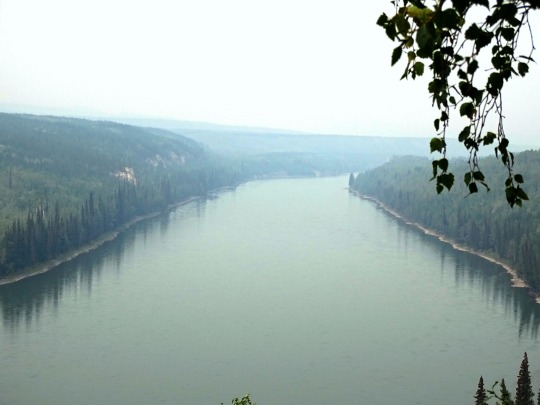
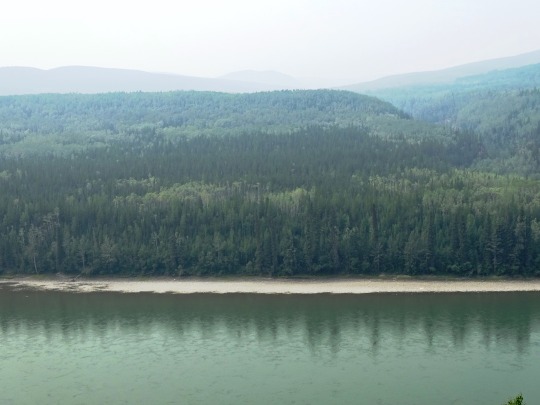
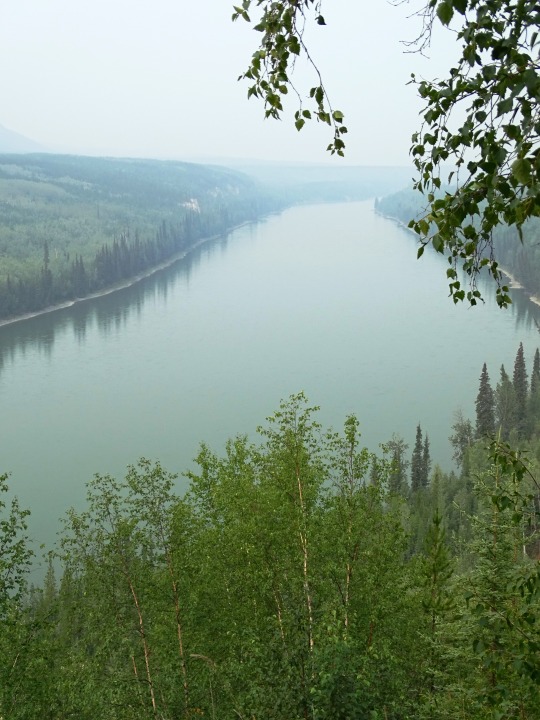
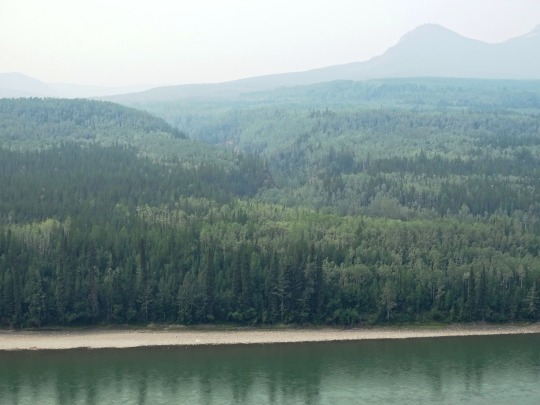
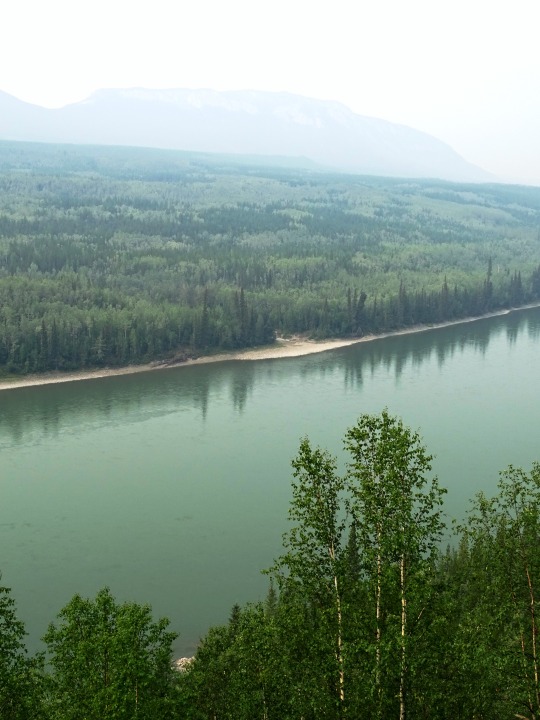
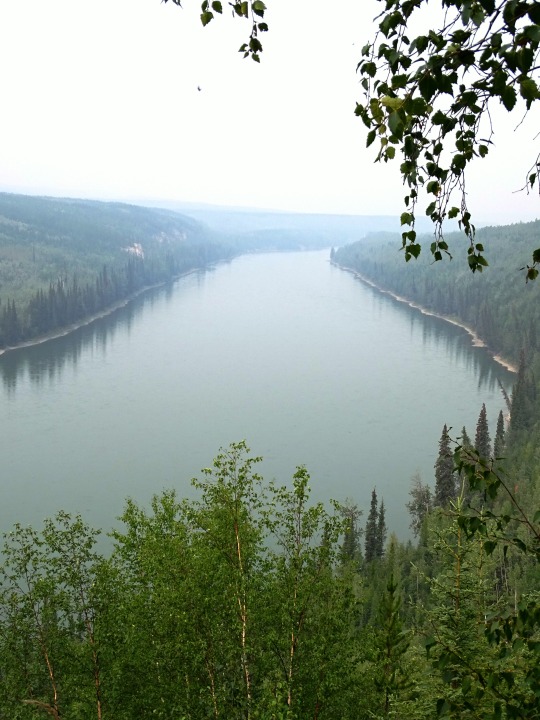



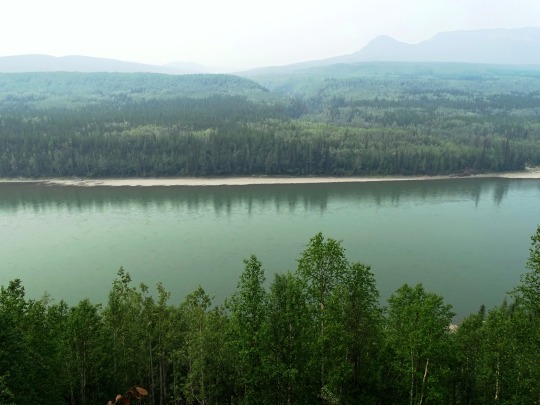
Allen's Lookout, BC (No. 2)
The Indigenous name for the river is Nêtʼił Tué', which means Hanging Down River in the Kaska language. The name comes from a particularly narrow spot near the river's headwaters, where Kaska people used to set goat snares. The "hanging down" - "Nêtʼił" part of the name refers to the snares. The origin of the river's name in mainstream use today is obscure, but is derived from the French word for "Eastern Cottonwood" (a kind of poplar) which grow in abundance along sections of the river. Among the early fur traders, who traveled the river corridor the Liard above the Fort Nelson River was referred to as the "West Branch," while the Fort Nelson River was the "East Branch."
The first European to traverse most of the river was John McLeod of the Hudson's Bay Company (HBC). Leaving Fort Simpson on June 28, 1831, McLeod and eight others ascended the river, reaching and naming the Dease River in just over six weeks. Four days later, they reached the Frances River, and mistakenly ascended it, thinking it was the Liard's main branch. Nine years later, another HBC employee, Robert Campbell, journeyed to the source of the Liard in the St. Cyr Range, renaming the river McLeod had ascended for Frances Ramsay Simpson, the wife of the Sir George Simpson, the HBC's governor who had authorised both expeditions.
The entire Yukon and British Columbia's portion of the river corridor is said to be the traditional unceded territory of the Kaska Dena, who have lived in the area for thousands of years and claim it as their rightful home. This claim is contested by both the Acho Dene Koe First Nation and Fort Nelson First Nation who count among their memberships the former residents of communities along the Liard, east of the Grand Canyon of the Liard, like Nelson Forks, La Jolie Butte, and Francois, where the Acho Dene Koe signed Treaty 11. Their descendants still live and hunt in the area to this day. Despite Kaska Dene claims, much of the area has been recognized as Fort Nelson and Acho Dene Koe First Nation territory under Treaty 8 and 11 since 1910 and 1922 respectively.
Source: Wikipedia
#Allen's Lookout#BC#Liard River#travel#original photography#vacation#tourist attraction#landmark#landscape#countryside#British Columbia#woods#forest#nature#flora#tree#river bank#wildfire smoke#summer 2023#Canada#view#vista point#boreal forest#Northern Rockies#Rocky Mountains#wildflower#blooming
13 notes
·
View notes
Text

Rob Rogers
* * * *
LETTERS FROM AN AMERICAN
January 13, 2024
HEATHER COX RICHARDSON
JAN 14, 2024
Last night a woman and two children drowned in the Rio Grande that marks the border between the U.S. and Mexico near Eagle Pass, Texas.
U.S. Border Patrol agents knew that a group of six migrants were in distress in the river but could not try to save them, as they normally would, because troops from the Texas National Guard and the Texas Military Department prevented the Border Patrol agents from entering the area where they were struggling: Shelby Park, a 47-acre public park that offers access to a frequently traveled part of the river and is a place where Border Patrol agents often encounter migrants crossing the border illegally.
They could not enter because two days ago, on Thursday, Texas governor Greg Abbott sent armed Texas National Guard soldiers and soldiers from the Texas Military Department to take control of Shelby Park. Rolando Salinas, the mayor of Eagle Pass, posted a video on Facebook showing the troops and saying that a state official had told him that state troops were taking “full control” over Shelby Park “indefinitely.” Salinas made it clear that “[t]his is not something that we wanted. This is not something that we asked for as a city.”
The Texas forces have denied United States Border Patrol officials entry into the park to perform their duties, asserting that Texas officials have power over U.S. officials.
On December 18, Abbott signed into law S.B. 4, a measure that attempts to take into state hands the power over immigration the Constitution gives to the federal government. Courts have repeatedly reinforced that immigration is the responsibility of federal, not state, government, but now, according to Uriel J. García of the Texas Tribune, “some Texas Republicans have said they hope the new law will push the issue back before a U.S. Supreme Court that is more conservative since three appointees of former President Donald Trump joined it.”
On January 3 the Department of Justice filed a lawsuit against the new law, saying: “Texas cannot run its own immigration system. Its efforts, through S.B. 4, intrude on the federal government’s exclusive authority to regulate the entry and removal of noncitizens, frustrate the United States’ immigration operations and proceedings, and interfere with U.S. foreign relations.”
Abbott and MAGA Republicans are teeing up the issue of immigration as a key line of attack on President Joe Biden in 2024, but while they are insisting the issue is so important they will not agree to fund Ukraine’s resistance to Russia’s 2022 invasion until it is solved, they are also unwilling to participate in discussions to fund more border officers or immigration courts. Today, once again, Biden reminded reporters that he has asked Congress to pass new border measures since he took office, but rather than pass new laws, Republicans appear to be doubling down on pushing the idea that migrants threaten American society and that an individual state—Texas, in this case—can override federal authority.
Abbott has spent more than $100 million of Texas tax dollars to send migrants to cities led by Democrats. These migrants have applied for asylum and are waiting for a hearing; they are in the U.S. legally. In September 2023, Texas stopped coordinating with nonprofits in those cities that prepared for migrant arrivals.
Yesterday, Illinois governor J.B. Pritzker wrote to Abbott, calling him out for choosing “to sow chaos in an attempt to score political points.” Pritzker noted that Abbott is “sending asylum seekers from Texas to the Upper Midwest in the middle of winter—many without coats, without shoes to protect them from the snow—to a city whose shelters are already overfilled with migrants you sent here.” Chicago’s temperatures are set to drop below zero this weekend, Pritzker wrote, and he “strongly urge[d]” Abbott to stop sending people to Illinois in these conditions. “You are dropping off asylum seekers without alerting us to their arrivals, at improper locations at all hours of the night.”
Pritzker wrote that he supports bipartisan immigration reform but “[w]hile action is pending at the federal level, I plead with you for mercy for the thousands of people who are powerless to speak for themselves. Please, while winter is threatening vulnerable people’s lives, suspend your transports and do not send more people to our state. We are asking you to help prevent additional deaths. We should be able to come together in a bipartisan fashion to urge Congress to act. But right now, we are talking about human beings and their survival. I hope we can at least agree on saving lives right now.”
Speaking on the right-wing Dana Loesch Show last week, Abbott said, “The only thing that we’re not doing is we’re not shooting people who come across the border, because of course the Biden administration would charge us with murder.”
On January 13, 1833, President Andrew Jackson wrote to Vice President–elect Martin van Buren to explain his position on South Carolina’s recent assertion that sovereign states could overrule federal laws. “Was this to be permitted the government would lose the confidence of its citizens and it would induce disunion everywhere. No my friend, the crisis must be now met with firmness, our citizens protected, and the modern doctrine of nullification and secession put down forever…. [N]othing must be permitted to weaken our government at home or abroad,” he wrote.
LETTERS FROM AN AMERICAN
HEATHER COX RICHARDSON
#Letters From An American#Heather Cox Richardson#Immigration#migrants#migration#Texas#history#Federal Law#vulnerable people#J.B. Pritzker#Abbot
9 notes
·
View notes
Text
January 13, 2024
HEATHER COX RICHARDSON
JAN 14
Last night a woman and two children drowned in the Rio Grande that marks the border between the U.S. and Mexico near Eagle Pass, Texas.
U.S. Border Patrol agents knew that a group of six migrants were in distress in the river but could not try to save them, as they normally would, because troops from the Texas National Guard and the Texas Military Department prevented the Border Patrol agents from entering the area where they were struggling: Shelby Park, a 47-acre public park that offers access to a frequently traveled part of the river and is a place where Border Patrol agents often encounter migrants crossing the border illegally.
They could not enter because two days ago, on Thursday, Texas governor Greg Abbott sent armed Texas National Guard soldiers and soldiers from the Texas Military Department to take control of Shelby Park. Rolando Salinas, the mayor of Eagle Pass, posted a video on Facebook showing the troops and saying that a state official had told him that state troops were taking “full control” over Shelby Park “indefinitely.” Salinas made it clear that “[t]his is not something that we wanted. This is not something that we asked for as a city.”
The Texas forces have denied United States Border Patrol officials entry into the park to perform their duties, asserting that Texas officials have power over U.S. officials.
On December 18, Abbott signed into law S.B. 4, a measure that attempts to take into state hands the power over immigration the Constitution gives to the federal government. Courts have repeatedly reinforced that immigration is the responsibility of federal, not state, government, but now, according to Uriel J. García of the Texas Tribune, “some Texas Republicans have said they hope the new law will push the issue back before a U.S. Supreme Court that is more conservative since three appointees of former President Donald Trump joined it.”
On January 3 the Department of Justice filed a lawsuit against the new law, saying: “Texas cannot run its own immigration system. Its efforts, through S.B. 4, intrude on the federal government’s exclusive authority to regulate the entry and removal of noncitizens, frustrate the United States’ immigration operations and proceedings, and interfere with U.S. foreign relations.”
Abbott and MAGA Republicans are teeing up the issue of immigration as a key line of attack on President Joe Biden in 2024, but while they are insisting the issue is so important they will not agree to fund Ukraine’s resistance to Russia’s 2022 invasion until it is solved, they are also unwilling to participate in discussions to fund more border officers or immigration courts. Today, once again, Biden reminded reporters that he has asked Congress to pass new border measures since he took office, but rather than pass new laws, Republicans appear to be doubling down on pushing the idea that migrants threaten American society and that an individual state—Texas, in this case—can override federal authority.
Abbott has spent more than $100 million of Texas tax dollars to send migrants to cities led by Democrats. These migrants have applied for asylum and are waiting for a hearing; they are in the U.S. legally. In September 2023, Texas stopped coordinating with nonprofits in those cities that prepared for migrant arrivals.
Yesterday, Illinois governor J.B. Pritzker wrote to Abbott, calling him out for choosing “to sow chaos in an attempt to score political points.” Pritzker noted that Abbott is “sending asylum seekers from Texas to the Upper Midwest in the middle of winter—many without coats, without shoes to protect them from the snow—to a city whose shelters are already overfilled with migrants you sent here.” Chicago’s temperatures are set to drop below zero this weekend, Pritzker wrote, and he “strongly urge[d]” Abbott to stop sending people to Illinois in these conditions. “You are dropping off asylum seekers without alerting us to their arrivals, at improper locations at all hours of the night.”
Pritzker wrote that he supports bipartisan immigration reform but “[w]hile action is pending at the federal level, I plead with you for mercy for the thousands of people who are powerless to speak for themselves. Please, while winter is threatening vulnerable people’s lives, suspend your transports and do not send more people to our state. We are asking you to help prevent additional deaths. We should be able to come together in a bipartisan fashion to urge Congress to act. But right now, we are talking about human beings and their survival. I hope we can at least agree on saving lives right now.”
Speaking on the right-wing Dana Loesch Show last week, Abbott said, “The only thing that we’re not doing is we’re not shooting people who come across the border, because of course the Biden administration would charge us with murder.”
On January 13, 1833, President Andrew Jackson wrote to Vice President–elect Martin van Buren to explain his position on South Carolina’s recent assertion that sovereign states could overrule federal laws. “Was this to be permitted the government would lose the confidence of its citizens and it would induce disunion everywhere. No my friend, the crisis must be now met with firmness, our citizens protected, and the modern doctrine of nullification and secession put down forever…. [N]othing must be permitted to weaken our government at home or abroad,” he wrote.
7 notes
·
View notes
Text
History
New Year's Day - The most celebrated holiday around the world.
January 1, 1502 - Portuguese explorers landed at Guanabara Bay on the coast of South America and named it Rio de Janeiro (River of January). Rio de Janeiro is currently Brazil's second largest city.
January 1, 1660 - Samuel Pepys began his famous diary in which he chronicled life in London including the Great Plague of 1664-65 and the Great Fire of 1666.
January 1, 1776 - During the American Revolution, George Washington unveiled the Grand Union Flag, the first national flag in America.
January 1, 1801 - Ireland was added to Great Britain by an Act of Union thus creating the United Kingdom of Great Britain and Ireland.
January 1, 1863 - The Emancipation Proclamation by President Abraham Lincoln freed the slaves in the states rebelling against the Union.
January 1, 1877 - Queen Victoria was proclaimed Empress of India.
January 1, 1892 - Ellis Island in New York Harbor opened. Over 20 million new arrivals to America were processed until its closing in 1954.
January 1, 1901 - The Commonwealth of Australia was founded as six former British colonies became six states with Edmund Barton as the first prime minister.
January 1, 1915 - During World War I, the British Battleship Formidable was hit by a torpedo in the English Channel, killing 547 crewmen.
January 1, 1942 - Twenty six countries signed the Declaration of the United Nations, in Washington, D.C., reaffirming their opposition to the Axis powers and confirming that no single nation would make a separate peace.
January 1, 1958 - The EEC (European Economic Community) known as the Common Market was formed by Belgium, France, West Germany, Italy, Luxembourg and The Netherlands in order to remove trade barriers and coordinate trade policies.
January 1, 1959 - Fidel Castro seized power in Cuba after leading a revolution that drove out Dictator Fulgencio Batista. Castro then established a Communist dictatorship.
January 1, 1973 - Britain, Ireland and Denmark became members of the Common Market (EEC).
January 1, 1975 - During the Watergate scandal, former top aides to President Nixon including former Attorney General John Mitchell, Domestic Affairs Advisor John Ehrlichman and Chief of Staff H.R. Haldeman, were found guilty of obstruction of justice.
January 1, 1979 - China and the U.S. established diplomatic relations, 30 years after the foundation of the People's Republic.
January 1, 1993 - Czechoslovakia broke into separate Czech and Slovak republics.
January 1, 1999 - Eleven European nations began using a new single European currency, the Euro, for electronic financial and business transactions. Participating countries included; Austria, Belgium, Finland, France, Germany, Ireland, Italy, Luxembourg, Netherlands, Portugal and Spain.
Birthday - American Patriot Paul Revere (1735-1818) was born in Boston, Massachusetts. Best known for his ride on the night of April 18, 1775, warning Americans of British plans to raid Lexington and Concord.
Birthday - Betsy Ross (1752-1836) was born in Philadelphia, Pennsylvania. She was a seamstress credited with helping to originate and sew the Stars and Stripes flag of America in 1776.
9 notes
·
View notes
Text
The Nations of the Basin: Part 2
Part 1 - Part 3
Below the cut is a brief introduction to two more of the major nations in my D&D campaign. Tomorrow I'll start introducing the minor nations.
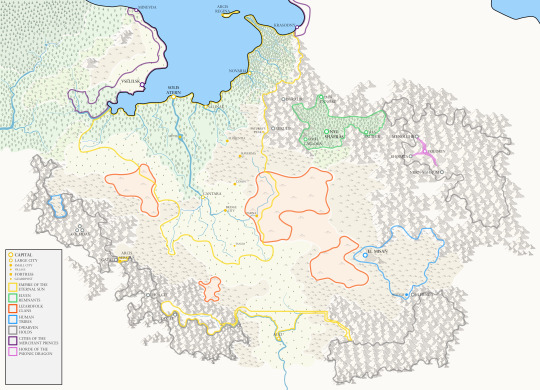
The Lizardfolk
Lying in the deserts of the Basin, no one is exactly sure when the lizardfolk appeared or where they came from, though they claim to have been formed from the sand itself by their four dragon-gods; Ekhez, Talroz, Olkan, and Kheilki. For as long as the lizardfolk have been around, they have ambushed caravans that enter the desert and harassed the Empire as it encroached on their territory. But there is yet another group of lizardfolk, as swimming throughout the rivers of the Basin are the crocodile-folk, followers of their goddess Sthonis.
Population: ~240k. Lizardfolk, Dragonblessed
Faiths: Draconic Pantheon
Languages: Common, Draconic
The lizardfolk are quite meritocratic, one’s worth is determined how well one can support themselves and those they hold close. But some lizardfolk have the advantage of being blessed by their dragon-gods, and these long-lived dragonblessed take leading roles in their clan and provide some measure of continuity for the oft-short-lived lizardfolk. Each clan of lizardfolk has a slightly different culture: the crystal lizardfolk are wise and diplomatic, the bronze lizardfolk militaristic and honorable, the brass lizardfolk sociable and egalitarian, the gold lizardfolk secretive and devout, and the turquoise crocodile-folk individualistic and temperamental.
The Human Tribes
Entering the Basin in significant numbers a bit over a century ago, the twelve human tribes are each descended from a great individual and their followers who took part in a failed rebellion among their homeland to the southeast. The tribes have quickly adapted to life in the Basin, creating permanent settlements in the highlands of the southeast, and otherwise living a nomadic lifestyle. Six of the twelve tribes are the Athir, Bakar, Erdemir, Farida, Kamil, and Zuhr.
Population: ~350k. Human
Faiths: Ancestor Worship
Languages: Common, Human
Each of the tribes is divided further into clans, which are composed of about a dozen families. These clans are the main unit that humans travel in. A tribal meeting between all the clans in a tribe might occur once every five years, or if some event requires an emergency meeting. Every 20 years, a Grand Council is convened between all tribes, with the vast majority of the nomadic human population in attendance. Lingering inter-tribal conflicts are often brought to the forefront during the Council. However, a custom of ritualized dueling keeps most conflicts contained, with little risk of significant escalation to full blown war.
3 notes
·
View notes
Text
The federal Animal and Plant Health Inspection Service is proposing to spray toxic insecticides within treasured and significant landscapes of the Colorado Plateau in northern Arizona to kill native grasshoppers.
The areas being considered include portions of the Vermilion Cliffs National Monument, Grand Canyon-Parashant National Monument, and the newly designated Baaj Nwaavjo I’tah Kukveni – Ancestral Footprints of the Grand Canyon National Monument.
“This is a dangerous plan that could kill creatures that are key to northern Arizona’s unique biodiversity, which these national monuments were designated to protect,” said Taylor McKinnon, Southwest director at the Center for Biological Diversity. “The federal government needs to stop downplaying the extinction crisis and back off its reckless plan to smother biodiversity hotspots with toxic pesticides.”
One out of every 10 plant species in the Colorado Plateau region is found nowhere else on Earth.
The agency's draft environmental assessment omits mention of the national monuments and unique species and habitats they were designated to protect. These species include rare bees, butterflies and other creatures found nowhere else, like the Kaibab monkey grasshopper and House Rock Valley chisel-toothed kangaroo rat, specifically named in the August proclamation establishing the Baaj Nwaavjo I’tah Kukveni National Monument.
APHIS oversees and funds the application of multiple pesticides on rangelands to prevent native grasshoppers and Mormon crickets from competing with livestock for forage.
The proposed insecticides — carbaryl, diflubenzuron and chlorantraniliprole — are indiscriminate. In addition to the grasshoppers the agency is targeting, the insecticides can also kill bees, moths and other insects. Spraying can harm entire ecosystems by disrupting pollination and can harm populations of birds, reptiles and mammals who feed on grasshoppers and insects.
Although grasshoppers and Mormon crickets can be locally abundant from time to time, native plants and other wildlife evolved with these cycles. Introducing pesticides to eliminate native grasshoppers is a shortsighted, quick fix that fails to consider the complex interrelationships within these delicate ecosystems.
The agency’s draft analysis shows that it has failed to consult with affected Tribes with ties to the Grand Canyon area. The Grand Canyon Tribal Coalition, which proposed the Baaj Nwaavjo I’tah Kukveni National Monument, includes members of the Havasupai Tribe, Hopi Tribe, Hualapai Tribe, Kaibab Band of Paiute Indians, Las Vegas Tribe of Paiutes, Moapa Band of Paiute Indians, Paiute Indian Tribe of Utah, Shivwits Band of Paiutes, Navajo Nation, San Juan Southern Paiute Tribe, Yavapai-Apache Nation, Zuni Tribe and Colorado River Indian Tribes.
“It’s so important that APHIS honor the promise made to work together with Tribal nations to protect the sacred spaces and resources within the Baaj Nwaavjo I’tah Kukveni Monument when it was established less than six months ago,” said Sharon Selvaggio, pesticide program specialist with The Xerces Society for Invertebrate Conservation. “We call on the agency to protect natural systems on Tribal and public lands by employing nonchemical management that allows humans and wildlife to thrive.”
In March 2023 the U.S. Environmental Protection Agency published a draft biological opinion from NOAA Fisheries showing that carbaryl is likely to jeopardize 37 species protected under the Endangered Species Act, and harm 36 designated critical habitats.
While Arizona is not home to any of the species named in that report, the findings show the extreme harm carbaryl poses to endangered fish and other species.
The U.S. Fish and Wildlife Service, which is charged with protecting endangered plants and animals, has not yet completed a proper analysis of the potential harms from the APHIS proposal. Potentially vulnerable endangered species in Arizona include Chiricahua leopard frogs, western yellow-billed cuckoos, Gila chub, black-footed ferrets and Siler pincushion cacti.
APHIS is accepting comments on the proposal until 4 p.m. MST on Feb. 2.
#ecology#enviromentalism#pesticides#Baaj Nwaavjo I'tah Kukveni Monument#grand canyon#Grand Canyon national monument#Vermillion Cliffs National Monument#arizona#colorado plateau#Animal and Plant Health Inspection Service#APHIS#epa#fish and wildlife#wildlife services#Fuck Wildlife Services#insecticide#endangered species act#endangered species
4 notes
·
View notes
Photo

“Eight Indian Pupils Found After Quest,” Toronto Globe. October 26, 1932. Page 2.
----
Brantford, Oct. 25. - After wandering about the Six Nations Reserve, near here, since last night, four girls and four boys, ranging in ages from 14 to 15, returned back tonight to the Indian Institute from which they were missing.
Rev. H. W. Snell, in charge of the Institute, reported last night that seven girls and four boys, all dressed in the institute’s uniform, were missing. Search parties were organized to hunt for them, but during last night and today eight of the runways had either been found or had returned of their own accord.
Mr. Snell stated tonight that he knew where the three girls who are still missing could be located.
[AL: Make no mistake, though the story is trying to avoid this, but these young men and women were running away - escaping - from a residential school, a genocidal part of the Canadian settler state.]
#brantford#residential school#indian residential schools#escape from custody#prison break#escaped prisoners#indian institute#haudenosaunee#first nations#indigenous people#great depression in canada#settler colonialism in canada#crime and punishment in canada#history of crime and punishment in canada#teenage runaways#mohawk institute residential school#six nations of the grand river
4 notes
·
View notes
Text
Along Texas' floating border barrier, migrant children left bloody by razor wire
Updated 7:25 pm EDT Jul. 21, 2023
EAGLE PASS, Texas – By the time Omar Tortua and his family waded into the warm river water at Piedras Negras, they had already survived a treacherous journey through the jungle of the Darién Gap, across six countries and past cartel kidnappers.
But it was only at the end that Tortua saw the danger claw into his own child, when a coil of concertina wire – placed at the American shoreline, by Texas officials – ensnared the leg of his 5-year-old son.
He scooped up the bleeding child, with officers watching from the riverbank above.
All along this river bank, scraps of clothing bear witness to the many migrants who have been snared by razor wire in recent weeks. And as federal and state officials clash over Texas' latest border security initiative, the migrants who reach the United States display its toll, in bruises and broken ankles and glinting rows of surgical staples that hold closed slice wounds. An internal e-mail from a Texas state trooper, revealed this week, raised the alarm that the state's efforts had become "inhumane." On Friday, USA TODAY observed how that razor wire has slashed not just adults but young children.
Tortua, 27, from Venezuela, had waded into the Rio Grande early Wednesday. With him were his wife, Yamilet Castillo, 31, and their sons, Jesús and Elias. The boys are twins, the kind of kids who giggle together at each new sight, wide-eyed and curious at the world.
The family had already been trekking for weeks. Turning back now was not an option.
They shuffled, waist-deep, along the river’s edge, maneuvering around coils of lacerating wire in the water and stepping carefully over more that stuck out along the banks.
From the Texas bank of the river, men in vehicles trailed them slowly. Whether the agents were state troopers, National Guard or Border Patrol, the family didn't know. They were simply policías, and they were calling out instructions: Tortua and his family would have to keep going, downriver to a staging area – or return to Mexico.
As he climbed around one rock in the river, Jesús slipped and stumbled onto a wire coil that jutted out. It slashed into his left calf, leaving a two-inch gash. Blood spilled into the water. Jesús let out a shrieking cry.
The authorities called out, from the other side of the wire, saying they could help. Tortua reached over the coils and handed them his son.
The authorities wrapped the boy’s cut. But they made the rest of the family continue farther downstream, before allowing them up on the banks, Tortua said.
Somewhere along the way, a medic treated the boy’s leg. His family was turned over to U.S. Border Patrol, where they were processed and released until their court date.
“It was horrible,” Tortua said Friday from inside the Mission: Border Hope migrant shelter just outside Eagle Pass. He pulled up Jesús’ pant leg to show the four medical staples it took to seal the gash.
“I don’t understand: If they were just going to arrest us and let us go, why do they have to put all that up?” he said. “It doesn’t seem right.”
“All that” is the miles of razor wire Texas has erected on the banks of the Rio Grande to deter unauthorized crossings.
Attention to them has amplified this week along with controversy over Texas’ other attempt at a border barrier: a 1,000-foot string of floating orange buoys the state deployed at midstream. Purchased from a government security contractor, the “floating wall” is designed to trap swimmers, in a river that often runs knee-deep and warm in the summer sun, but where the tranquil surface hides dark pockets of head-high water.
In the past week, migrants, including many children, have arrived at the Eagle Pass shelter with an array of injuries: lacerations, welts, open wounds. Pregnant women have high blood pressure from stress, said Valeria Wheeler, the shelter’s executive director, and migrants have gashes in heads and faces. The shelter has also been accepting an usually high number of migrants recently released from hospitals, she said.
“This is the worst I’ve ever seen it,” Wheeler said. “They’re putting lives at risk.”
Revelations of those injuries have drawn widespread condemnation from immigrant advocates, Democratic leaders and other agencies. By the end of the week, the Justice Department warned Texas that it planned to file suit over the floating barrier.
“The State of Texas’s actions violate federal law, raise humanitarian concerns, present serious risks to public safety and the environment, and may interfere with the federal government’s ability to carry out its official duties,” the department wrote in a letter to Gov. Greg Abbott, which was obtained by USA TODAY.
The letter gives Texas until Monday to commit to removing the barrier and warns that, if there is no response, the administration will proceed with a lawsuit.
The coils of wire also restrict U.S. Border Patrol agents from accessing the river and helping migrants in distress.
“We can enforce the law and, at the same time, ensure that we prioritize the wellbeing of those we encounter,” a Border Patrol spokesperson said in a statement. “We are very concerned by reports of actions that not only make it harder for Border Patrol agents to enforce our nation’s immigration laws, but also put lives in danger.”
Texas Gov. Greg Abbott’s border actions brought condemnation from the White House.
"The governor’s actions are cruel and putting both migrants and border agents in danger," White House spokesman Abdullah Hasan told USA TODAY Friday. "The Department of Justice made clear that it is prepared to take the governor to court if he doesn’t immediately remove the unlawful structures in the Rio Grande."
A floating border wall in Texas, and a whistleblower's warning
The Texas Department of Public Safety and Texas state guard have been uncoiling miles of concertina wire along the banks of the Rio Grande since 2021 as part of Operation Lone Star, Abbott’s multi-billion initiative to use state resources to curtail unauthorized border crossings. More than 90 miles of the sharp-edged wire has been unfurled throughout South Texas, according to DPS.
The dangers of the razor wire entered the spotlight, though, when a recent email by a Texas DPS trooper to his superiors was made public. The July 3 email by trooper and paramedic Nicholas Wingate, first reported by the Houston Chronicle, describes how he and fellow troopers came across large groups of men, women and children along the banks of the Rio Grande and were ordered by commanders to “push the people back into the water” toward Mexico.
The email, which DPS provided to USA TODAY, also described encountering a male migrant with a “significant laceration” on his left leg while extricating his child from the razor wire and a 19-year-old pregnant woman having a miscarriage while stuck in the wiring. He also alleged troopers were directed not to give water or medical attention to migrants.
“I believe we have stepped over a line into the in humane [sic],” Wingate wrote.
Two weeks later, on July 15, DPS director Steve McCraw dispatched an email to regional directors with the subject line “Incidents Involving Concertina Wire – DPS,” in which he reminded DPS leaders that crossing through “the concertina wire without protective gear is no doubt likely to result in an injury. This is self evident, but we need to ensure that migrants are reminded of this by signage and continued verbal warnings …”
Internal memos show DPS was circulating photos of border-crossers wounded by the wire. One shows a migrant with a long gash along the torso that had been medically stapled shut. Others show a bloodied finger and leg injuries. A memo lists seven incidents, between July 4 and July 13, where migrants had been caught in the concertina wire, including a mother and child who had been transported to the hospital with cuts and another migrant who was transported to San Antonio for “treatment with several lacerations that required staples.”
McCraw’s directive says agents would continue to save lives, and notes that a soldier died during a water rescue – an apparent reference to an incident last year.
But the directive also echoes the orders Tortua heard as his children approached the razor wire.
“We will be able to prevent migrants from risking their lives by denying them access between the Ports of Entry,” McCraw wrote, “and encourage them to use one of the 29 Texas international bridges where they can safely cross.”
DPS’ Office of Inspector General is investigating the allegations made in Wingate’s email, agency spokesman Travis Considine said. “If our personnel are doing anything that violates policy, they will be held accountable,” he said in an email. “There are no orders from the top that prohibit Troopers from giving water to women and children or attending to migrants who need medical attention.”
In a joint statement from Abbott’s office, McCraw, Texas Border Czar Mike Banks and the Texas National Guard, state officials said they were taking steps to monitor the safety of migrants and provide medical attention to those in distress. They blamed President Joe Biden’s border policies for the need to ramp up enforcement.
“With migrants from over 150 countries encouraged by open border policies to risk their lives and make this dangerous trek to enter our country illegally, Texas is deploying every tool and strategy to deter and repel illegal crossings between ports of entry,” it said. “The absence of these tools and strategies—including concertina wire that snags clothing—encourages migrants to make potentially life-threatening and illegal crossings.”
But Texas may be overstepping its authority by deploying the buoys, experts said. Placing the buoys without consulting the U.S. section of the International Boundary and Water Commission violates the 1944 water treaty and 1970 treaty between the U.S. and Mexico, said Stephen Mumme, a Colorado State University political scientist and author of “Border Water: The Politics of U.S.-Mexico Transboundary Water Management, 1945-2015.”
Last week, high-ranking Mexican officials filed a complaint over the buoys. Considine, the DPS spokesman, would not comment on Mexico’s complaints. Neither would the U.S. State Department.
Mexico did not previously complain when border walls and fences went up on the U.S. side of the Rio Grande without consulting the commission, also a potential violation of the treaties, Mumme said. The fact that they are now raising complaints points to how serious Mexican officials consider the matter, he said.
“The state of Texas has no authority whatsoever to be doing what it’s doing,” Mumme said.
A border grove fenced like a prison
Just behind Heavenly Farms, a 300-acre pecan grove on the banks of the Rio Grande in Eagle Pass, coils of concertina wire are stacked one atop of the other, stretching for miles in either direction.
Sweaters, swim trunks and shards of T-shirts hang from the wires’ pointed barbs, left behind by migrants snagged by the wire. Humvees and trucks ferrying National Guard troops from Ohio and Missouri, U.S. Border Patrol trucks and DPS cruisers steadily rumble over dirt roads, kicking up clouds of dust.
Migrants are often caught in wire nearly submerged near two islands in the river or climbing over the coils to reach U.S. soil, said Magali Urbina, the farm’s owner. Urbina called the concertina wire “sickening” and she and her husband, Hugo Urbina, have repeatedly asked Texas authorities to remove the wire from their property, but they’ve refused, she said.
“It’s horrible,” Magali Urbina said. “I can’t imagine how many people have gotten caught in it.”
The Urbinas bought the land in 2021 as an idyllic retirement location, where they could gaze out at the churning waters of the Rio Grande and occasionally go fishing. Instead, it now more closely resembles a prison camp. Though streams of asylum-seekers stalked through her property last year, those numbers were already dwindling earlier this year before Texas put up the wire, she said.
Magali Urbina questioned if the wire will truly deter migrants.
“If they came from Venezuela, through the Darién Gap, this is not going to stop them,” she said, looking out at coils of stacked concertina wire at the edge of her property.
DPS officials said troopers should not be jeopardizing the wellbeing of migrants and have shared pictures on social media of troopers assisting migrants. But asylum-seekers at the Mission: Border Hope shelter, some with small children, described scenes of crossing the river only to be told by authorities on the U.S. side to return across the Rio Grande to Mexico or trek for miles downriver.
Reyna Gloria Domínguez, 42, from Honduras, crossed the river two weeks ago with her husband, Edemecio, and four children, ages 5 to 22. She was nursing a broken ankle she said she had suffered in Monterrey fleeing gunmen on her trip to the border. As the family arrived on the U.S. side and faced coils of concertina wire, authorities told her they would take her since she was injured but her family had to return to Mexico, she said.
Domínguez said she stood on the banks, dripping wet, and cried as she watched her family recross the Rio Grande and return to Mexico.
“I said, ‘God, please, where are you?’” she said through tears at the shelter on Friday, as she hugged a battered Bible. “I didn’t know if my children made it back to Mexico or were here or even alive.”
She added: “I never imagined that the United States would be so painful, so heartless.”
Diego Molina, 34, fled Honduras with his family earlier this year to flee criminal gangs who he said had shut down his business and extorted money from him. He needed to reach the U.S., he said, to save money and get a heart-valve operation done for his son, Diego, 10, to fix a heart condition.
As he crossed the Rio Grande earlier this week with Diego, his wife, Heidy Orellano, 33, and their 1-year-old daughter, Camila, he was met with rows of concertina wire. They crossed with a pregnant woman and her husband and a mother with two small children. As they puzzled how to get past the wire, U.S. authorities yelled at them to go further downriver and blared a siren at them, he said.
With water at times coming up to his neck, Molina led his family downriver. The men on the banks told them to keep going but his son was struggling to breathe. With sirens blaring and children crying, he stepped on razor wire protruding from the water and had his family amble on shore. The wire tore at his pants, but everyone made it to land. The authorities immediately called an ambulance for the pregnant woman and for his son.
“We didn’t think it would be like this,” Molina said from the shelter on Friday. “But once you cross from Mexico, you can’t go back.”
Michael Collins and Bart Jansen of USA TODAY contributed.
50 states.
Countless
viewpoints.
USA TODAY brings you the
nation's perspectives for greater
understanding of today's world.
INSTALL OUR APP
Originally Published 7:10 pm EDT Jul. 21, 2023
**Updated 7:25 pm EDT Jul. 21, 2023**
Hell’s finna be hot for people like Greg abbott. And I don’t care if the governor tells you to do it, when someone orders you to mistreat migrants in the same country that wouldn’t be where it is today without immigrants you better say NO.
#Greg abbott#conservatives#american politics#uspol#texas politics#gop#greg abbott#fuck greg abbott#european union#migration#immigrants#refugee crisis#refugees
10 notes
·
View notes
Photo



Robbie Robertson, Master Storyteller Who Led the Band, Dead at 80 – Rolling Stone
Robbie Robertson, The Band’s guitarist and primary songwriter who penned “The Weight,” “The Night They Drove Old Dixie Down,” “Up On Cripple Creek” and many other beloved classics, died Wednesday at age 80.
Robertson’s management company confirmed the musician’s death. “Robbie was surrounded by his family at the time of his death, including his wife, Janet, his ex-wife, Dominique, her partner Nicholas, and his children Alexandra, Sebastian, Delphine, and Delphine’s partner Kenny,” his longtime manager Jared Levine said in a statement. “In lieu of flowers, the family has asked that donations be made to the Six Nations of the Grand River to support the building of their new cultural center.”
The Band only lasted eight years after the release of their 1968 debut LP Music From Big Pink, but during that time they forever changed the pop culture landscape by releasing brilliant Americana music at the peak of the psychedelic movement. Their first album sent shockwaves through the industry, inspiring Eric Clapton to break up Cream, the Beatles to attempt their own stripped-back project with Let It Be and a pair of young British songwriters named Elton John and Bernie Taupin to begin writing and recording their own material.
Robertson took on the role as the group’s leader, writing the majority of their songs and pushing them forward when substance abuse issues and infighting threatened their existence. It was also his decision to pull the plug on the group in 1976 when he couldn’t take it anymore, setting the stage for their legendary farewell concert The Last Waltz.
“The road has taken a lot of the great ones,” he said at the time. “Hank Williams, Buddy Holly, Otis Redding, Janis, Jimi Hendrix, Elvis. It’s a goddamn impossible way of life.” ...
6 notes
·
View notes
Text
Robbie Robertson, The Band Legend, Dies At 80
Robbie Robertson, The Band Legend, Dies At 80
The Band lead guitarist Robbie Robertson has died at age 80.
“Robbie was surrounded by his family at the time of his death, including his wife, Janet, his ex-wife, Dominique, her partner Nicholas, and his children Alexandra, Sebastian, Delphine, and Delphine’s partner Kenny,” Jared Levine, Robertson’s manager of 34 years, 0said in a statement. “He is also survived by his grandchildren Angelica, Donovan, Dominic, Gabriel, and Seraphina.”
Robertson recently worked on music for the upcoming “Killers of the Flower Moon.” His family asked that, in lieu of flowers, donations be made to the Six Nations of the Grand River.
youtube
#Robbie Robertson#Rest in peace#The Band#Singer#legendary guitarist#Up on cripple creek#the last waltz#Musician#70s music#70s bands#Classic rock#Rock bands#celebrity news#Celebs#Celebrities#celebrity death#Youtube
6 notes
·
View notes
Text

Kimowan Metchewais, “Cold Lake Fishing”, 2004/06

Koyoltzintli, “Gathering Roots” and “Spider Woman Embrace”, Abiquiú, New Mexico, 2019, from the series MEDA, 2018/19, Archival pigment print
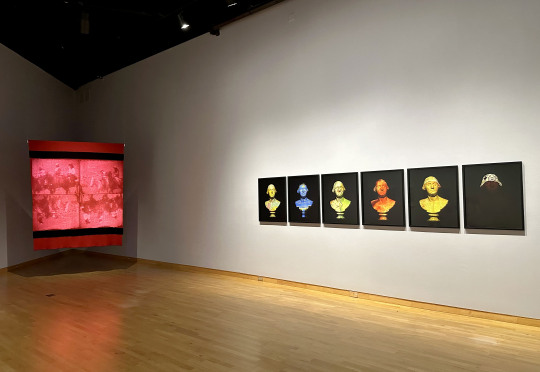
(Alan Michelson “Hanödagayas (Town Destroyer): Whirlwind Series”, 2022 Archival pigment prints and “Pehin Hanska ktepi (They Killed Long Hair)”, 2021 Single-channel video installation: wool blanket and video projection; 1:05 minutes (looped), no sound)
Currently at the USF Contemporary Art Museum is Native America: In Translation curated by Wendy Red Star and organized by Aperture. The work included offers viewers a chance to discover new perspectives on the Native American experience.
From the museum-
“The ultimate form of decolonization is through how Native languages form a view of the world. These artists provide sharp perceptions, rooted in their cultures.” —Wendy Red Star
Native America: In Translation assembles the wide-ranging work of nine Indigenous artists who pose challenging questions about identity and heritage, land rights, and histories of colonialism. Probing the legacies of settler colonialism, and photography’s complex and often fraught role in constructing representation of Native cultures, the exhibition includes works by lens-based artists offering new perspectives on Indigenous identity, reimagining what it means to be a citizen in North America today.
Works included in the exhibition address cultural and visual sovereignty by reclaiming Native American identity and representation. Honoring ancestral traditions and stories tied to the land, Koyoltzintli (Ecuadorian-American, b. 1983) reflects on how the landscape embodies traditional knowledge, language, and memories. Nalikutaar Jacqueline Cleveland’s (Yup’ik, b. 1979) photographs of contemporary tribal communities in western Alaska document Native foraging and cultural traditions as a form of knowledge passed through generations. Revealing stories of trauma and healing, Guadalupe Maravilla (American, b. El Salvador, 1976) communicates autobiographical and fictional narratives informed by myth and his own migration story.
Expanding Indigenous archives and collective memory through photographic means, works by the late artist Kimowan Metchewais (Cree, Cold Lake First Nations, 1963–2011), drawn from his personal archive of Polaroid photographs, construct self-realized Native imagery challenging the authority of colonial representation. Excavating repressed colonial histories of invasion and eviction, Alan Michelson (Mohawk, Six Nations of the Grand River, b. 1953) reinterprets and repositions archival material to redress history from an Indigenous perspective. Marianne Nicolson’s (Musgamakw Dzawada’enuxw First Nations, b. 1969) light-based installation projects Dzawada’enuxw tribal symbols of authority and power onto colonized spaces to contest treaties that imposed territorial boundaries on Indigenous lands. Duane Linklater (Omaskêko Ininiwak from Moose Cree First Nation, b. 1976) reconfigured the pages sourced from a 1995 issue of Aperture, featuring Indigenous artists, creating space for artistic improvisation and reinvention across generations.
Reflecting on performative aspects of Indigeneity and the colonial gaze, Martine Gutierrez’s (American, b. 1989) series of photographs reinterpret high-fashion magazine spreads with a revolving roster of identities and narratives to question Native gender and heritage. Working across performance and photography, Rebecca Belmore (Anishinaabe, Lac Seul First Nation, b. 1960) creates powerful reenactments of past performances incorporating organic materials that reference knowledge, labor, and care of the Earth in defiance of state violence of Indigenous people.
This exhibition closes 12/1/23.

Rebecca Belmore, “matriarch”, 2018, and “mother” from the series “nindinawemaganidog (all of my relations)”, 2018, Archival pigment prints

Photos by Rebecca Belmore and Installation by Marianne Nicolson
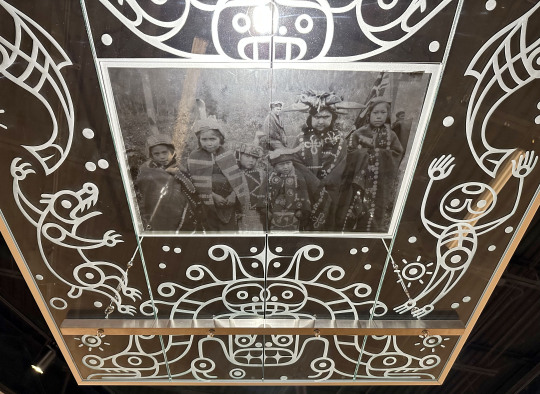

Marianne Nicolson’s installation detail
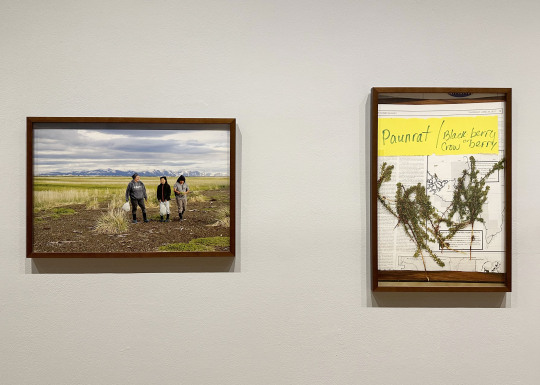
Nalikutaar Jacqueline Cleveland, “Molly Alexie and her children after a harvest of beach greens in Quinhagak, Alaska”, 2018 and “There are two main Yup’ ik names for crowberries or blackberries in Alaska, “paunrat” and “tangerpiit””, 2017, Archival pigment prints

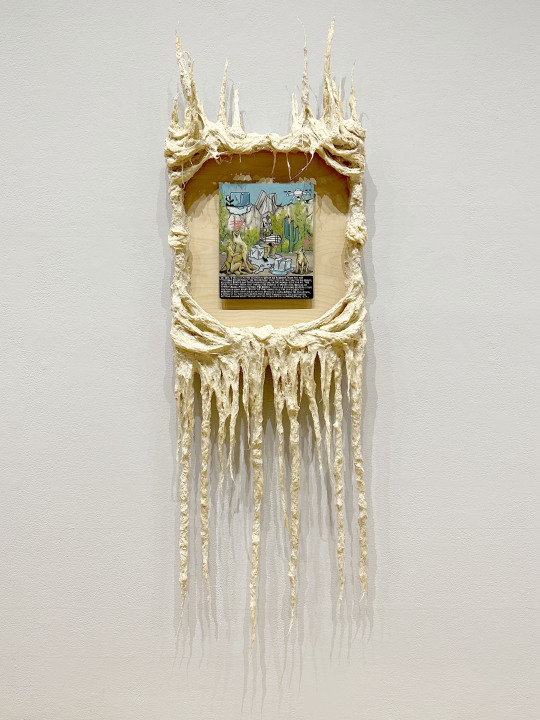
Guadalupe Maravilla, “I Crossed the Border Retablo”, 2021, Oil on tin, cotton, glue mixture, wood


Duane Linklater, “ghost in the machine”, 2021, Archival pigment prints

Martine Gutierrez, “Queer Rage, Dear Diary, No Signal During VH1’s Fiercest Divas”, and “Queer Rage, THat Girl Was Me, Now She’s A Somebody”, 2018. digital chromogenic print

One of Kimowan Metchewais’ polaroids from the slide show
#USF Contemporary Art Museum#Native American Artists#Rebecca Belmore#Kimowan Metchewais#Alan Michelson#Martine Gutierrez#Institute For Research in Art#Marianne Nicolson#Duane Linklater#Koyoltzintli#Guadalupe Maravilla#Nalikutaar Jacqueline Cleveland#Mixed Media#Mixed Media Art#Art#Mixed Media Photography#Native American#Native American Art#Native American Heritage Month#Black and White Photography#Art Shows#Florida Art Shows#Native American History#Photography#Polaroid#Polaroid Photography#Tampa Art Shows
4 notes
·
View notes